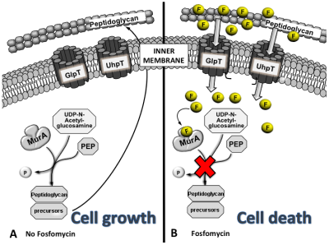Team II Comparative Genomics Group: Difference between revisions
No edit summary |
|||
| Line 28: | Line 28: | ||
==References== | ==References== | ||
Castañeda-García, Alfredo, Jesús Blázquez, and Alexandro Rodríguez-Rojas. "Molecular mechanisms and clinical impact of acquired and intrinsic fosfomycin resistance." Antibiotics 2.2 (2013): 217-236.<br> | |||
Nikolaidis I, Favini-Stabile S, Dessen A. 2014. Resistance to antibiotics targeted to the bacterial cell wall. Protein Sci 23: 243–259.<br> | |||
Kidd, Timothy J et al. “A Klebsiella Pneumoniae Antibiotic Resistance Mechanism That Subdues Host Defences and Promotes Virulence.” EMBO Molecular Medicine 9.4 (2017): 430–447.<br> | |||
Guo, Qinglan et al. “Glutathione-S-Transferase FosA6 of Klebsiella Pneumoniae Origin Conferring Fosfomycin Resistance in ESBL-Producing Escherichia Coli.” Journal of Antimicrobial Chemotherapy 71.9 (2016): 2460–2465.<br> | |||
Gardner, Shea N., Tom Slezak, and Barry G. Hall. "kSNP3. 0: SNP detection and phylogenetic analysis of genomes without genome alignment or reference genome." Bioinformatics31.17 (2015): 2877-2878. <br> | |||
Shea N Gardner, Tom Slezak, Barry G. Hall; kSNP3.0: SNP detection and phylogenetic analysis of genomes without genome alignment or reference genome, Bioinformatics, Volume 31, Issue 17, 1 September 2015, Pages 2877–2878. <br> | |||
Kim, Mincheol, et al. "Towards a taxonomic coherence between average nucleotide identity and 16S rRNA gene sequence similarity for species demarcation of prokaryotes." International journal of systematic and evolutionary microbiology 64.2 (2014): 346-351.<br> | |||
Revision as of 15:28, 15 April 2018
Introduction
Background
Comparative genomics is the study of comparing genome sequences to better understand the structure and function of genes.
Fosfomycin
Fosfomycin is a natural antibacterial produced by various Streptomyces and Pseudomonas species. It is the only antibiotic currently in clinical use that targets a Mur enzyme. It is broad-spectrum bactericidal antibiotic that can be employed against both Gram-positive and Gram-negative bacteria. It interferes with cell wall synthesis, particularly inhibits the initial step involving phosphoenolpyruvate synthetase, as shown below.

Resistance of Fosfomycin involves a wide range of resistance mechanisms. Some of them include reduced uptake, target site modification, expression of antibiotic-degrading enzymes and rescue of the UDP-MurNAc biogenesis pathway (ex. mutation within MurA enzyme).
Objectives
To identify genetic determinants that could be a potential cause for Fosfomycin heteroresistance in the isolates provided.
Data
The following is the metadata of our study:

Whole Genome Approach
Phylogeny Approach
Results and Discussion
References
Castañeda-García, Alfredo, Jesús Blázquez, and Alexandro Rodríguez-Rojas. "Molecular mechanisms and clinical impact of acquired and intrinsic fosfomycin resistance." Antibiotics 2.2 (2013): 217-236.
Nikolaidis I, Favini-Stabile S, Dessen A. 2014. Resistance to antibiotics targeted to the bacterial cell wall. Protein Sci 23: 243–259.
Kidd, Timothy J et al. “A Klebsiella Pneumoniae Antibiotic Resistance Mechanism That Subdues Host Defences and Promotes Virulence.” EMBO Molecular Medicine 9.4 (2017): 430–447.
Guo, Qinglan et al. “Glutathione-S-Transferase FosA6 of Klebsiella Pneumoniae Origin Conferring Fosfomycin Resistance in ESBL-Producing Escherichia Coli.” Journal of Antimicrobial Chemotherapy 71.9 (2016): 2460–2465.
Gardner, Shea N., Tom Slezak, and Barry G. Hall. "kSNP3. 0: SNP detection and phylogenetic analysis of genomes without genome alignment or reference genome." Bioinformatics31.17 (2015): 2877-2878.
Shea N Gardner, Tom Slezak, Barry G. Hall; kSNP3.0: SNP detection and phylogenetic analysis of genomes without genome alignment or reference genome, Bioinformatics, Volume 31, Issue 17, 1 September 2015, Pages 2877–2878.
Kim, Mincheol, et al. "Towards a taxonomic coherence between average nucleotide identity and 16S rRNA gene sequence similarity for species demarcation of prokaryotes." International journal of systematic and evolutionary microbiology 64.2 (2014): 346-351.